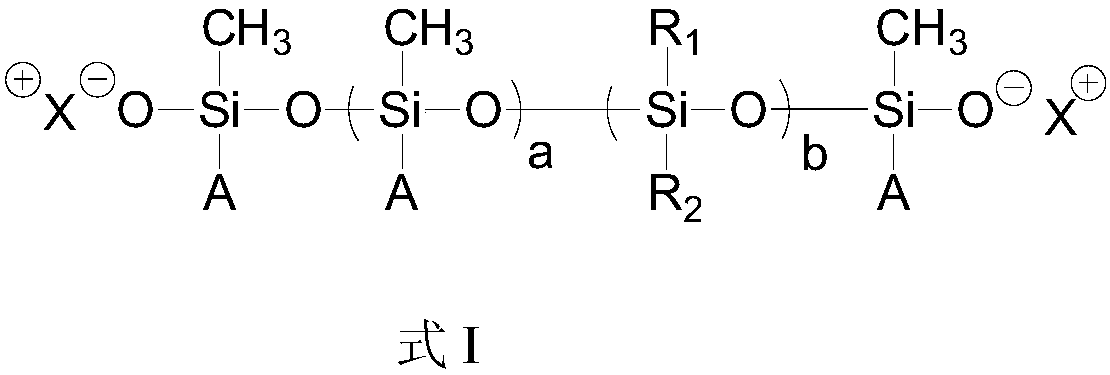Silanol salt-terminated organo-silicon polyamine curing agent and self-repairing epoxy resin produced therewith
A technology of epoxy resin and curing agent, which is applied in the field of epoxy resin, can solve problems such as limiting the scope of use, and achieve the effects of low cost, simple preparation process, and simple repair method
- Summary
- Abstract
- Description
- Claims
- Application Information
AI Technical Summary
Problems solved by technology
Method used
Image
Examples
Embodiment 1
[0051] Example 1. Synthesis of aminopolysiloxane
[0052] 540g of 3-aminopropylmethyldimethoxysilane and 144g of deionized water were added to a 1L three-necked flask equipped with mechanical stirring, a thermometer and a reflux condenser, heated to 60°C for hydrolysis and condensation reaction, and the reaction continued for 12h. After the reaction, vacuum distillation was performed to remove methanol and water produced during the condensation process to obtain 375 g of colorless and transparent aminopropyl methyl polysiloxane product with a number-average molecular weight of 1200, named PAMS-1.
Embodiment 2
[0053] Example 2. Synthesis of Aminopolysiloxane
[0054] Add 620g N-aminoethyl-3-aminopropylmethyldimethoxysilane and 144g deionized water in a 2L three-necked flask equipped with mechanical stirring, a thermometer and a reflux condenser, and heat to 80°C to carry out a hydrolysis condensation reaction , the reaction lasted 9h. After the reaction was completed, vacuum distillation was performed to remove methanol and water generated during the condensation process to obtain 442g of colorless and transparent N-aminoethyl-3-aminopropylmethylpolysiloxane products with a number-average molecular weight of 1458, named as PAMS-2.
Embodiment 3
[0055] Example 3. Synthesis of Aminopolysiloxane
[0056] 900g of diethylenetriaminopropylmethyldimethoxysilane and 144g of deionized water were added to a 2L three-necked flask equipped with mechanical stirring, a thermometer and a reflux condenser, and heated to 90°C for hydrolysis and condensation reaction, and the reaction continued for 4h . After the reaction, vacuum distillation was performed to remove methanol and water produced during the condensation process to obtain 746 g of a colorless and transparent diethylenetriaminopropylmethylpolysiloxane product with a number-average molecular weight of 2251, named PAMS-3.
PUM
 Login to View More
Login to View More Abstract
Description
Claims
Application Information
 Login to View More
Login to View More - R&D
- Intellectual Property
- Life Sciences
- Materials
- Tech Scout
- Unparalleled Data Quality
- Higher Quality Content
- 60% Fewer Hallucinations
Browse by: Latest US Patents, China's latest patents, Technical Efficacy Thesaurus, Application Domain, Technology Topic, Popular Technical Reports.
© 2025 PatSnap. All rights reserved.Legal|Privacy policy|Modern Slavery Act Transparency Statement|Sitemap|About US| Contact US: help@patsnap.com



